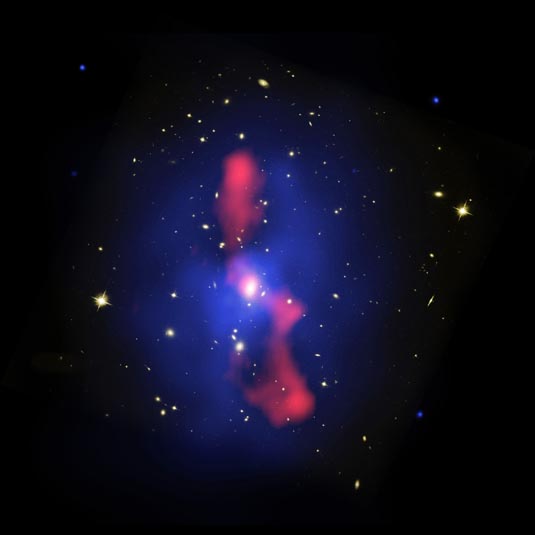
Description: Galaxy Cluster
Position (J2000): R.A. 07h 41m 50.20s Dec. +74° 14' 51.00"
Constellation: Camelopardalis
Distance: About 2.6 billion light years
Dimensions: This image is 4 arcminutes (3 million light-years or 900 kiloparsecs) wide.
Image Credit: NASA, ESA, and B. McNamara (University of Waterloo)
Release Date: November 2, 2006
ABOUT THIS IMAGE:
In Jan. 2005, astronomers reported that a supermassive black hole, lurking in the central bright galaxy, generated the most powerful outburst seen in the universe. The VLA radio image show jets of high energy particles (in red) streaming from the black hole. These jets pushed the X-ray emitting hot gas (shown in blue) aside to create two giant cavities in the gas. The cavities are evidence for the massive eruption. The X-ray and radio images show the enormous appetite of large black holes and the profound impact they have on their surroundings.
This is a composite image of galaxy cluster MS0735.6+7421, located about 2.6 billion light-years away in the constellation Camelopardalis. The image represents three views of the region that astronomers have combined into one photograph.
The optical view of the galaxy cluster, taken by the Hubble Space Telescope's Advanced Camera for Surveys in February 2006, shows dozens of galaxies bound together by gravity. Diffuse, hot gas with a temperature of nearly 50 million degrees permeates the space between the galaxies. The gas emits X-rays, seen as blue in the image taken with the Chandra X-ray Observatory in November 2003.
The X-ray portion of the image shows enormous holes or cavities in the gas, each roughly 640,000 light-years in diameter - nearly seven times the diameter of the Milky Way. The cavities are filled with charged particles gyrating around magnetic field lines and emitting radio waves shown in the red portion of image taken with the Very Large Array telescope in New Mexico in October 2004. The cavities were created by jets of charged particles ejected at nearly light speed from a supermassive black hole weighing nearly a billion times the mass of our Sun lurking in the nucleus of the bright central galaxy. The jets displaced more than one trillion solar masses worth of gas. The power required to displace the gas exceeded the power output of the Sun by nearly ten trillion times in the past 100 million years.
Color:
This image is a composite of many separate exposures made by several different instruments from three missions.. The color results from assigning different hues (colors) to each monochromatic image. In this case, the assigned colors are:
Chandra x-ray
telescope: February 1, 2006 blue
Hubble space telescope: November 30, 2003 green
VLA radio telescope: October
24, 2004 red